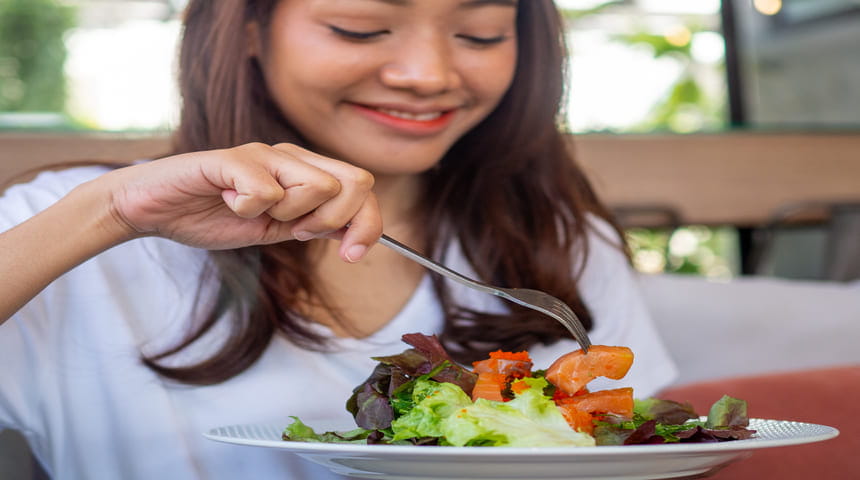Eat the Rainbow With These Strategies and Recipes
It’s simple: the more colorful your plate, the more nutritious your meal. And now is a great time to ask yourself if you’re eating enough fruits and vegetables. Your food doesn’t need to match all the colors in the rainbow, but the more variety, the better chance you’ll be consuming plenty of cancer-fighting nutrients. Increasing your fruit and vegetable intake doesn’t just help reduce your risk of developing cancer, it also may lower your risk of heart disease, diabetes and obesity.
Think you’re eating enough already? You might be surprised. Only 1 in 10 Americans is meeting their dietary need for fruits and vegetables, according to the Centers for Disease Control and Prevention (CDC). The CDC’s dietary guidelines recommend you fill half of your plate with fruits and vegetables.
Why Are Green Veggies So Important?
Phytochemicals, which are natural substances found in a variety of fruits and vegetables, along with whole grains, nuts and seeds, can help lower cancer risk. Antioxidants are a type of phytochemical.
Some foods rich in phytochemicals include:
-
Cruciferous vegetables, including broccoli, Brussels sprouts, cabbage, celery and soybeans. These may help reduce estrogen and carcinogens in the body.
-
Tart green apples, kiwi, grapes.
-
Leafy greens, which contain folate and build healthy cells.
-
Garlic, onions, chives and asparagus. All can help destroy cancer cells and support the immune system.
-
Fresh herbs. Oregano, basil, cilantro and parsley are just as nutrient dense as vegetables. Fresh herbs contain vitamins A, C and K, and polyphenols (another type of phytochemical).
Are Green Foods Better?
Are green foods better than their counterparts? The short answer is no — no one fruit or vegetable is the best or better than others. They all provide cancer fighting, anti-inflammatory nutrients to nourish your body. You should aim for at least two servings of fruit and three servings of vegetables every day.
Prevention Starts with a Healthful Diet
In addition to making sure you are eating the recommended amount of fruits and vegetables , you should:
-
Eat mostly whole grains, plant-based proteins (beans, lentils, soy) and lean animal protein (fish, poultry)
-
Limit added sugars and saturated fats
-
Drink less alcohol
-
Limit red/processed meats
3 Green Recipes
Pineapple Green Smoothie
Ingredients
½ cup almond milk
⅓ cup nonfat plain Greek yogurt
1 cup spinach
1 cup fresh or frozen bananas
½ cup pineapple chunks
1 tablespoon chia seeds
1-2 tablespoons maple syrup or honey (optional)
Directions
Blend ingredients until smooth and enjoy!
Serves: 1
Nutritional Information
Calories: 297, Fat: 6g (Saturated fat: 1g), Cholesterol: 4mg, Carbs 54g, Total Sugars: 29g (added 0g), Protein: 13g (21g if using regular dairy), Fiber: 10g, Sodium: 145mg, Potassium: 1038mg
Arugula and Avocado Breakfast Sandwich
Ingredients
¼ cup plain nonfat yogurt
1 lemon, zested and juiced
Salt and pepper
2 eggs
4 slices multigrain bread, toasted
1 cup arugula
1 avocado, peeled, pitted and sliced
1 tablespoon pepitas (optional)
Directions
-
In a small bowl, mix yogurt, lemon juice and lemon zest. Season with a pinch of salt and pepper.
-
Heat a greased nonstick pan on medium-low heat. Crack and pour eggs into the pan.
-
Cook until whites are set, flip and cook for 1 minute for a runny yolk, 3 minutes for a fully cooked yolk.
-
Turn off heat and let sit while assembling the sandwich.
-
Place two slices of toast on two plates.
-
Spread an even layer of yogurt sauce over toast.
-
Top with a portion of arugula, avocado and egg, and pepitas if using.
-
Top with another slice of bread.
-
Cut the sandwiches in half and serve.
Serves: 2
Nutritional Information
Calories: 431, Fat 25g (Saturated: 5g, Polyunsaturated: 5g, Monounsaturated: 13g), Carbohydrates 40g, Sugar 7g, Fiber 13g, Protein 18g, Sodium 643mg
Spring Vegetable and Herb Salad
Ingredients
1 cup radishes, halved lengthwise
1 cup (1-inch) pieces asparagus
8 ounces sugar snap peas, trimmed
1½ tablespoons unsalted butter
1 teaspoon grated lemon rind
½ teaspoon kosher salt, divided
½ teaspoon black pepper, divided
2 cups loosely packed baby arugula
2 cups loosely packed fresh flat-leaf parsley leaves
1 cup torn fresh mint
1 tablespoon extra virgin olive oil
5 teaspoons fresh lemon juice, divided
Serves: 6
Directions
-
Bring a large saucepan filled with water to a boil over medium-high heat. Add radishes, asparagus and snap peas; cook 3 minutes or until crisp-tender. Drain. Plunge radish mixture into a bowl filled with ice water; let stand 2 minutes. Drain.
-
Heat a small saucepan over medium heat. Add butter to pan; cook 2 minutes or until lightly browned and fragrant. Remove pan from heat; stir in lemon rind, ¼ teaspoon salt and ¼ teaspoon pepper.
-
Combine arugula, parsley and mint in a large bowl. Add remaining ¼ teaspoon salt, remaining ¼ teaspoon pepper, oil and 1 tablespoon lemon juice; toss. Arrange arugula mixture on a platter; top with radish mixture. Drizzle with butter mixture and remaining 2 teaspoons juice. Serve immediately.
Nutritional Information
Calories: 89, Fat 5.6g (Saturated fat 2.2g, Monounsaturated fat 2.5g, Polyunsaturated Fat 0.5g), Protein 3g, Carbohydrate 8g, Fiber 4g, Cholesterol 8mg, Iron 3mg, Sodium 192mg, Calcium 86mg, Sugars 3g
Choose to Stay in Touch
Sign up to receive the latest health news and trends, wellness & prevention tips, and much more from Orlando Health.
Sign Up




